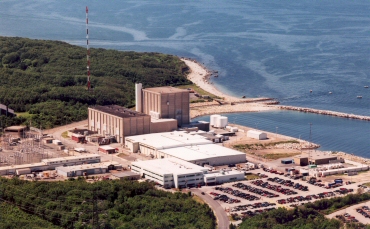One of the things that bothers me about the nuclear industry is that they are so intent on selling a new generation of nuclear reactors that they seem to not care much about the legacy of nuclear waste and deteriorating reactors left behind from decades of nuclear power. When the cost of nuclear power is calculated, I have always wondered just how much of the cost of cleaning up the existing mess is included in the cost quoted. I am afraid that the answer is that not all of the costs of nuclear power are being included in the calculations. A recent situation with respect to an old nuclear power reactor appears to confirm my fears.
In 2014, the Nuclear Regulatory Commission lowered the performance rating of the Pilgrim Nuclear Power Station in Massachusetts which is owned by Entergy. The Pilgrim plant was shut down so often in 2013 that it earned a place on the list of the nine worst performing nuclear power plants in the U.S. The NRC required that the plant be placed under "closer scrutiny" by NRC inspectors. In 2015, the plant has already had three unscheduled shutdowns. There are only three nuclear power plants in the whole U.S. which have this low rating. If there are more problems, the NRC will require that the plant be shut down permanently. Whether from NRC action or Entergy decisions, it is inevitable that the Pilgrim plant will have to be decommissioned.
The State of Massachusetts is concerned about the environmental and financial effects of decommissioning the Pilgrim Plant. In order to protect the nearby town of Pilgrim and the commonwealth, there are several bills related to nuclear power pending before the State House.
Senate bill S. 1798 would require the Pilgrim Plant owners to pay twenty five million dollars a year into a trust fund after the plant is closed to ensure that there is enough money to clean up the site after it stops operating. Pilgrim has a decommissioning fund with about nine hundred billion dollars in it.
However, in view of the fact that the cost for decommissioning the smaller Entergy Vermont Yankee plant is now estimated to be at least one billion two hundred million dollars, it appears that the existing decommissioning fund for Pilgrim is much too small. If that is indeed the case, the rate payers would have to make up the difference. In Connecticut, the rate payers wound up having to pay almost five hundred million dollars because their decommissioning fund for the Connecticut Yankee Power Plant was too small.
The NRC does not require decommissioning to be completed for up to sixty years after a nuclear power plant stops operating. If there are not enough funds to pay for full decommissioning when the Pilgrim plant is shut down, it may be put into a status called SAFSTOR which means that the spent fuel will be left in the spent fuel cooling pond or put into dry casks, the staff will be drastically reduced and Entergy will stop paying for environmental monitoring. This would leave the State with the job of protecting and monitoring the plant and the spent fuel for an indefinite period of time.
One of the dangers that a plant in SAFSTOR status faces is a spent fuel fire which could cost half a billion dollars and would devastate the city of Plymouth. Senate bill 1797 would impose a tax on spent fuel stored in cooling ponds. This would put pressure on Entergy to move the fuel to dry casks and reduce the threat of a fire.
Even if the Senate bills both pass, I will not be surprised if the rate payers of Massachusetts wind up paying more than expected for the nuclear power generated by the Pilgrim plant.
Pilgrim Nuclear Power Station:
